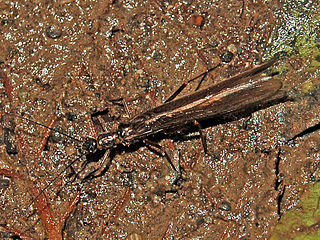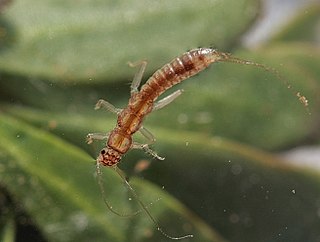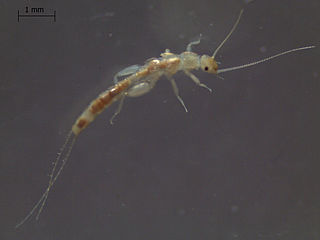
Plecoptera is an order of insects, commonly known as stoneflies. Some 3,500 species are described worldwide, with new species still being discovered. Stoneflies are found worldwide, except Antarctica. Stoneflies are believed to be one of the most primitive groups of Neoptera, with close relatives identified from the Carboniferous and Lower Permian geological periods, while true stoneflies are known from fossils only a bit younger. Their modern diversity, however, apparently is of Mesozoic origin.

The Perlodidae, also known as the perlodid stoneflies, stripetails, or springflies, are a family of stoneflies.

The Nemouridae are a family of stoneflies containing more than 700 described species, occurring primarily in the Holarctic region. Members of this family are commonly known as spring stoneflies or brown stoneflies. Fly fishermen often refer to these insects as tiny winter blacks.

The Capniidae, the small winter stoneflies, are a family of insects in the stonefly order (Plecoptera). It constitutes one of the largest stonefly families, containing some 300 species distributed throughout the holarctic. Their closest relatives are the rolled-winged stoneflies (Leuctridae).

Arctoperlaria is a suborder of stoneflies, with a World-wide distribution. The Plecoptera Species File divides this suborder as follows:

The Leuctridae are a family of stoneflies. They are known commonly as rolled-winged stoneflies and needleflies. This family contains at least 390 species.

Brachyptera is a genus of taeniopterygid stoneflies of mostly Western Palearctic distribution.
Paracapnia opis, the northeastern snowfly, is a species of small winter stonefly in the family Capniidae. It is found in North America. Described by Edward Newman in 1839, it was the first known insect in the genus Paracapnia. It is synonymous with Paracapnia curvata.

Paracapnia is a genus of small winter stoneflies in the family Capniidae. There are at least five species described in the genus Paracapnia. They are native to North America.

Isogenoides is a genus of springflies in the family Perlodidae. There are about eight described species in Isogenoides.

Perlodini is a tribe of Palaearctic and Nearctic stoneflies in the family Perlodidae. There are more than 80 described species in Perlodini.

Acroneuria is a genus of common stoneflies in the family Perlidae. There are more than 30 described species in Acroneuria.

Perlinella is a genus of common stoneflies in the family Perlidae. There are at least three described species in Perlinella.

Capnia is a genus of small winter stoneflies in the family Capniidae. There are at least 120 described species in Capnia.

Helopicus is a genus of springflies in the family Perlodidae. There are at least four described species in Helopicus.

Perla is a genus of common stoneflies in the family Perlidae. There are at least 30 described species in Perla.

Zwicknia is a genus of small winter stoneflies in the family Capniidae. There are about 11 described species in Zwicknia.
Isogenus nubecula, also known as scarce yellow sally, is a species of stonefly belonging to the family Perlodidae. It is native to Europe.

Stenoperla prasina is a species of stonefly belonging to the family Eustheniidae. This species is endemic to New Zealand and is classified as "Not Threatened" under the New Zealand Threat Classification System. It is found on the North, South and Stewart Island / Rakiura Islands as well as on Little Barrier Island. Although adults of this species are most often coloured bright green, this species can be coloured yellow. This species inhabits clean, cold, running streams and rivers with stony bottoms within native bush. It is a known indicator of water quality. The larvae eat plant detritus and other aquatic insects while the adult insects feed on sooty mould fungi as well as other plant matter. The adults of this species are a known food source for New Zealand long tailed bats. Adults have been dissected and have been found to have been carrying Nematomorpha and trematode parasites. The New Zealand Department of Conservation classifies this species as "Not Threatened". In 2022 a specimen of this species was the 5 millionth specimen to be digitised in the Natural History Museum, London collection.

Chloroperla is a genus of European stone-flies, erected by Edward Newman in 1836; it is the type genus of family Chloroperlidae, subfamily Chloroperlinae and tribe Chloroperlini Okamoto, 1912. Species are distributed in western Palaearctic freshwater habitats: especially Europe and including the British Isles.
















